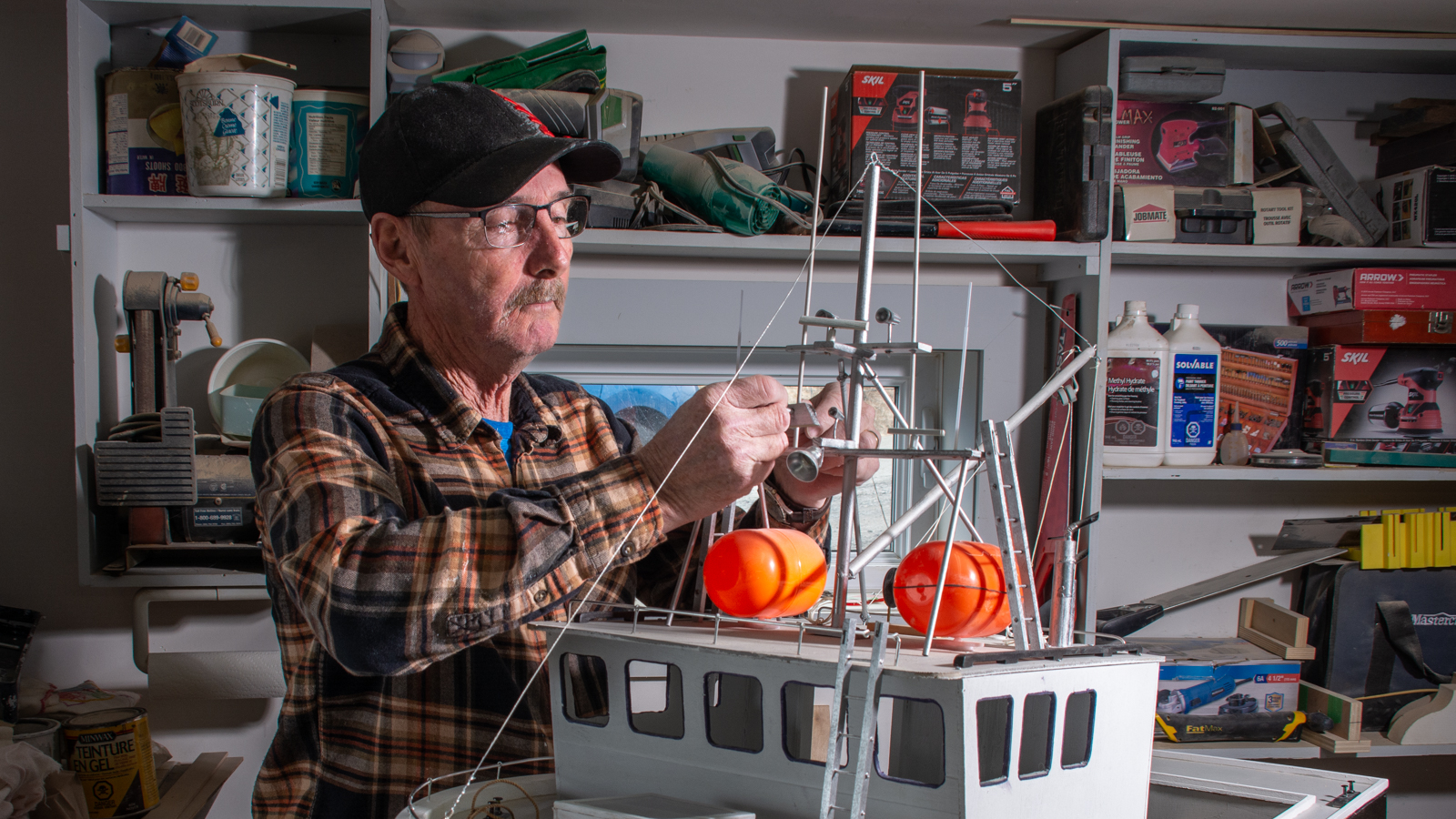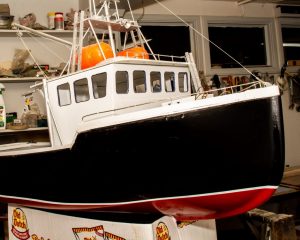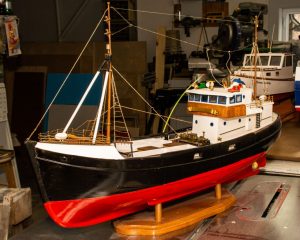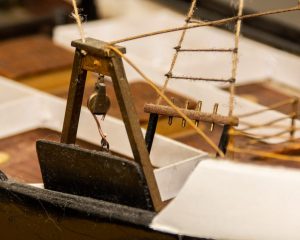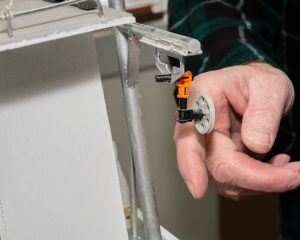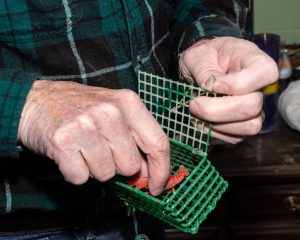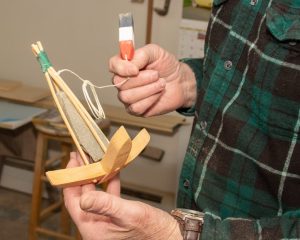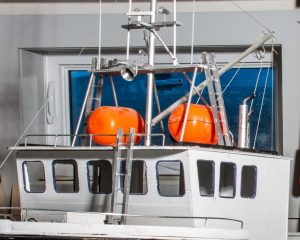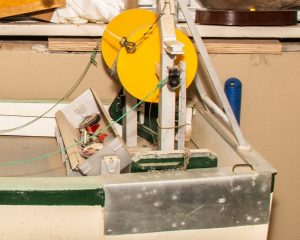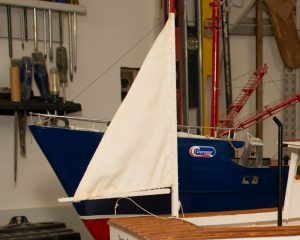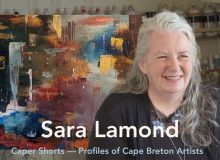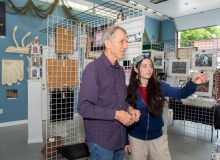Kevin Skinner’s Boats
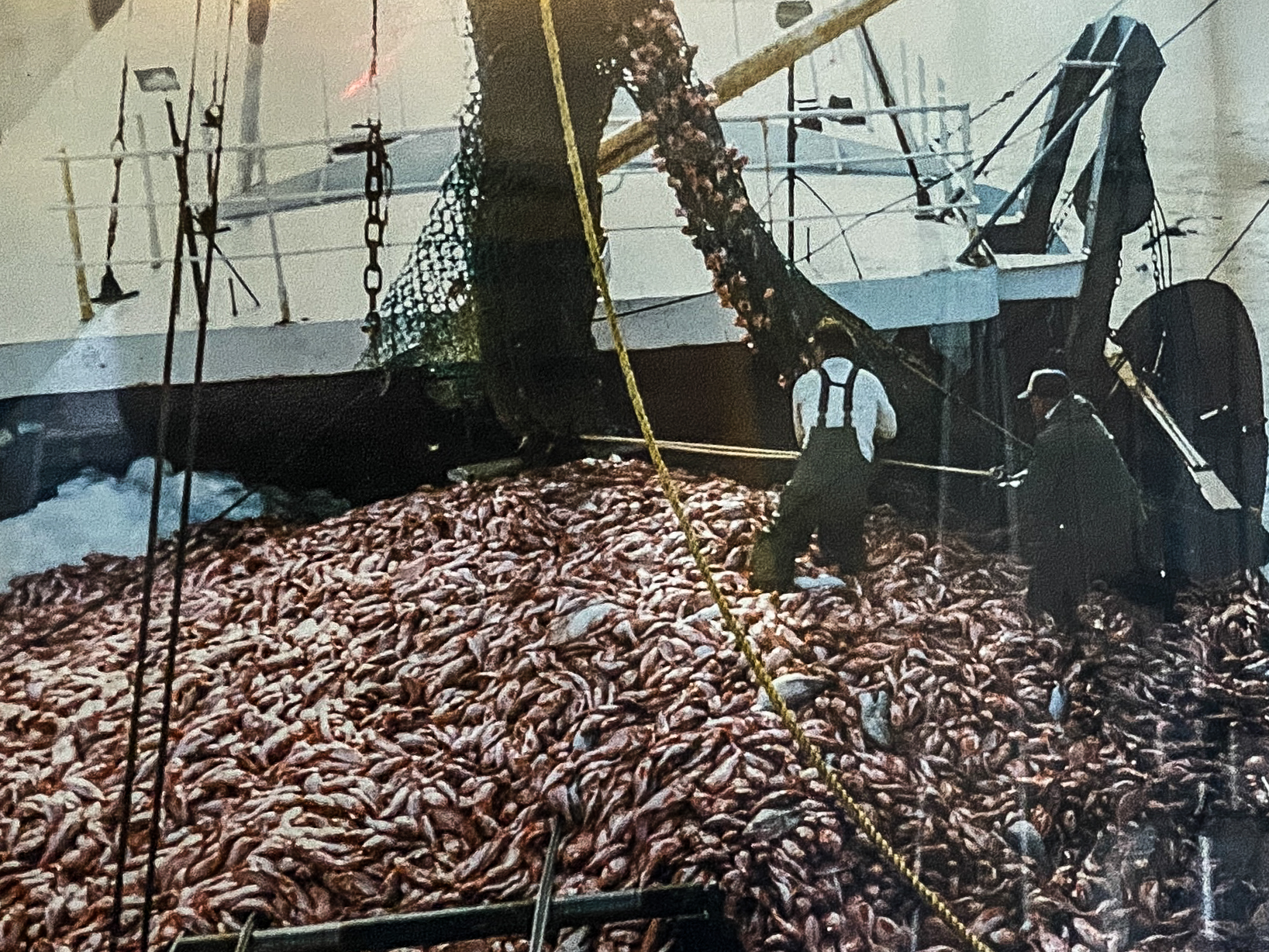
On the wall of Kevin Skinner’s basement there is a photo of him as a young man knee-deep in redfish on the deck of the side trawler Ann C. Spencer. Working next to him is his father, Freeman Skinner Sr., who also happened to be the captain, and they have just hauled up their catch of redfish over the side. The photo is from the seventies, back in the days when the Atlantic Canadian deep sea fishery was employing a lot of people in the area.
The Winnie Marie
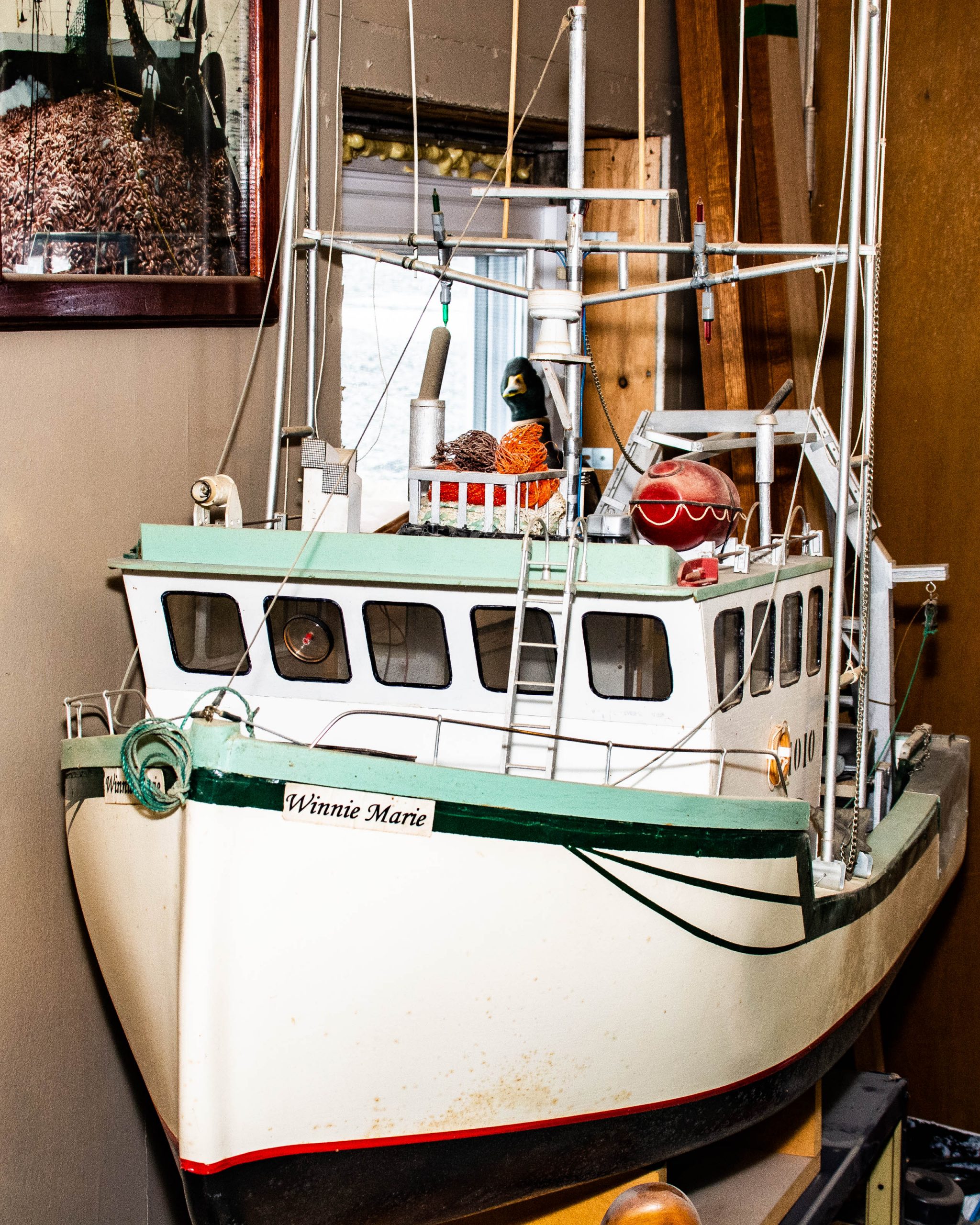
In front of that photo is a 51-inch long replica of a stern trawler called the Winnie Marie. “She’s a ground fish boat,” Kevin said, “redfish, halibut, haddock, any kind of ground fish.” It could also trawl for shrimp. It was the first model boat Kevin made 15 years ago and it is named for his wife. He made it under the guidance of his brother Brian who was a popular modeller in his day and former fisherman, too. Brian had been making them for 10 years. “When he took sick with cancer and couldn’t do it no more”, Kevin said, “he asked me to keep it going. And he passed on so I been doing it ever since.” He made the Winnie Marie under Brian’s watchful eye because Brian wanted Kevin to maintain the same standards. Since then Kevin has made over 100 boats. That was before his retirement which was due shortly after our interview.
Every boat tells a story — The Miss Ally
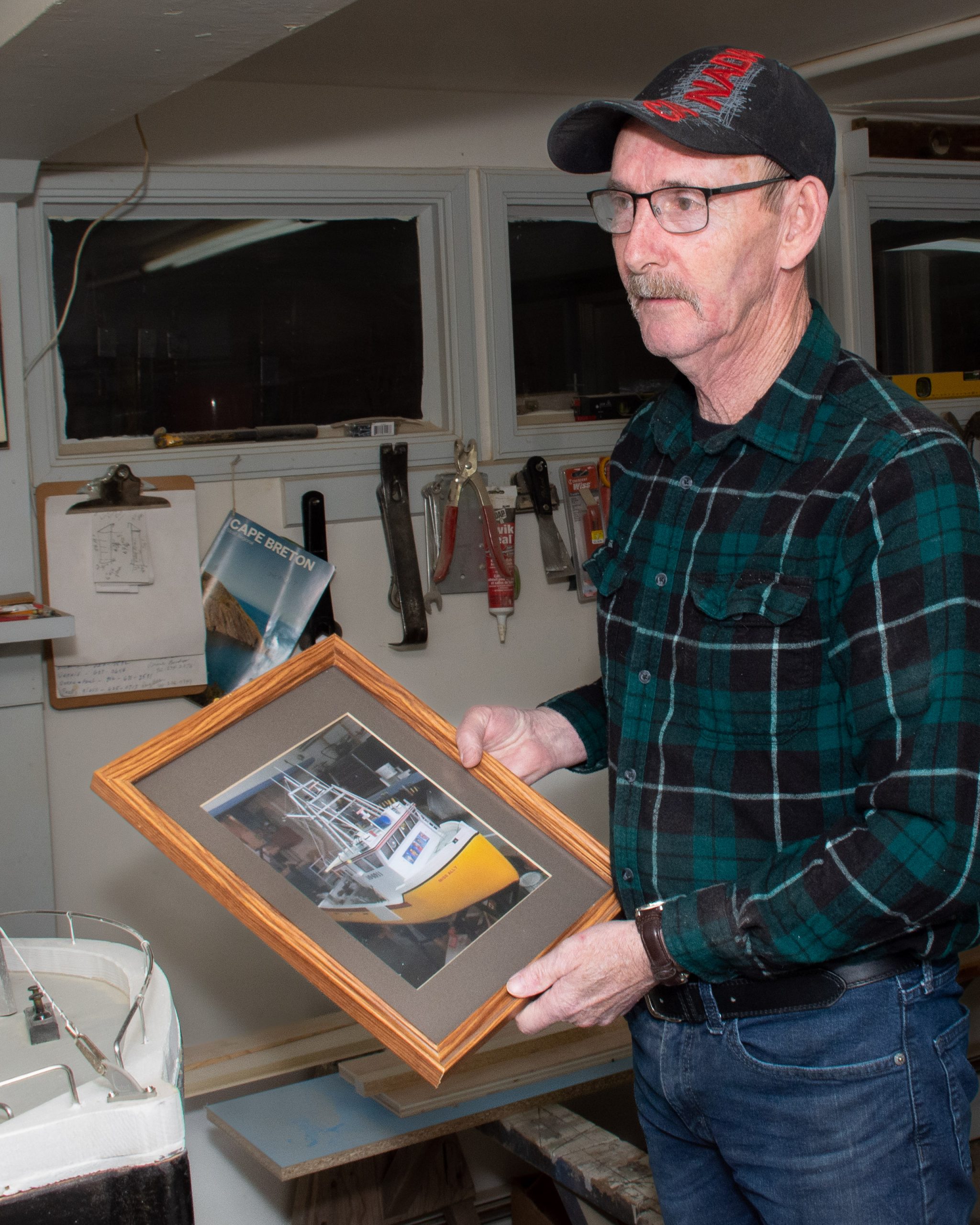
Every boat Kevin showed me had a story. Often it’s the story that inspired the boat’s making. Take the Miss Ally for example. “I don’t know if you heard about the story of this one,” he said. He showed me a photo of a model fishing boat with a yellow hull. “It’s the one about the halibut boat. It went down around Nova Scotia. They lost five crew members in the winter time. They called it Miss Ally.” The captain of the boat, Katlin Nickerson was 21. The oldest crew member was 34. Their bodies were never recovered.
I asked him if he remembered that day. “Yes, I do. I was here (meaning the wharf below his house on Upton Lane) watching the other fellows come in, the other two boats. They weren’t even tied down before they heard that she went. Just goes to show you what the sea will do.”
“I was going to take that (the model) down to Yarmouth where these fellas fished out of but they told me, no, they got enough stuff down there now that people made: little models, they made park benches, headstones.” So Kevin told them, “We’re going to have a pig roast up here, a pig roast we have every year. I’ll tell you, I’ll donate the boat and the money goes to the IWK (Izaak Walton Killiam Health Centre—a paediatric hospital). And that’s what I did with it.” They auctioned the boat off.
Another boat he donated was for a woman whose son died at the IWK. “They sold tickets on the boat to buy presents for the kids at the hospital,” Kevin said. “And they raised over $3,000.” So far he’s made five that he’s donated to raise money for the IWK. He also gave one to a local group to raise money to put a new roof on a former church turned community centre. There are others and he has to really think to remember all the ones he’s donated. “People come looking for me. I don’t ask many questions, I donate a boat and away it’s gone.”
When I asked him how much his boats go for when he sells them he said anywhere from $400 for a small model like the Seven Sisters to $3,000 for one that is “fully outrigged with a motor into it.”
“Time and materials. I don’t really charge a lot because I’ll never get paid for it.”
The Seven Sisters
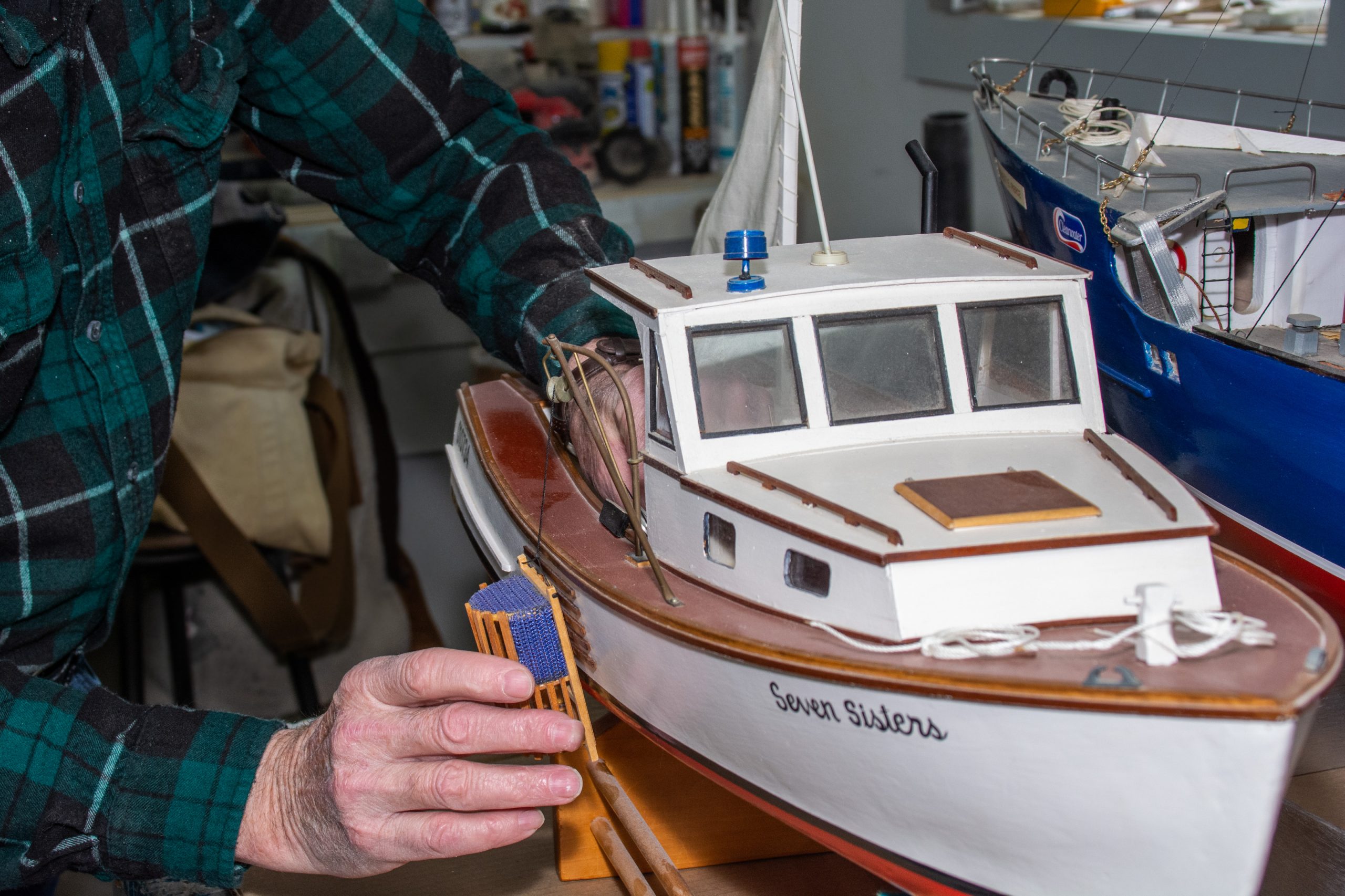
“This is one I made for my dad. He give it to my mom for a present. She’s called the Seven Sisters after my mom’s family. Seven girls in the family. I got it back after my dad passed. I turned around and gave it to one of my granddaughters. It’s a lobster boat.
His father, Freeman, was from Newfoundland. “I was five or six when I came here to live. He came over before that. Oh, it had to be close to 50 years he was up this way to Cape Breton. We lived in Louisbourg, we lived in North Sydney, then we lived in Petit-de-Grat and back to Arichat. He (his father) retired and he moved to Newfoundland. My sister died and he moved back here.”
The Seven Sisters was just the right size for the mobile home his father lived in at the end. “Nothing too big,” Kevin said, “he could put it somewhere and look at it and cherish it.”
The Ernest E. Pierce
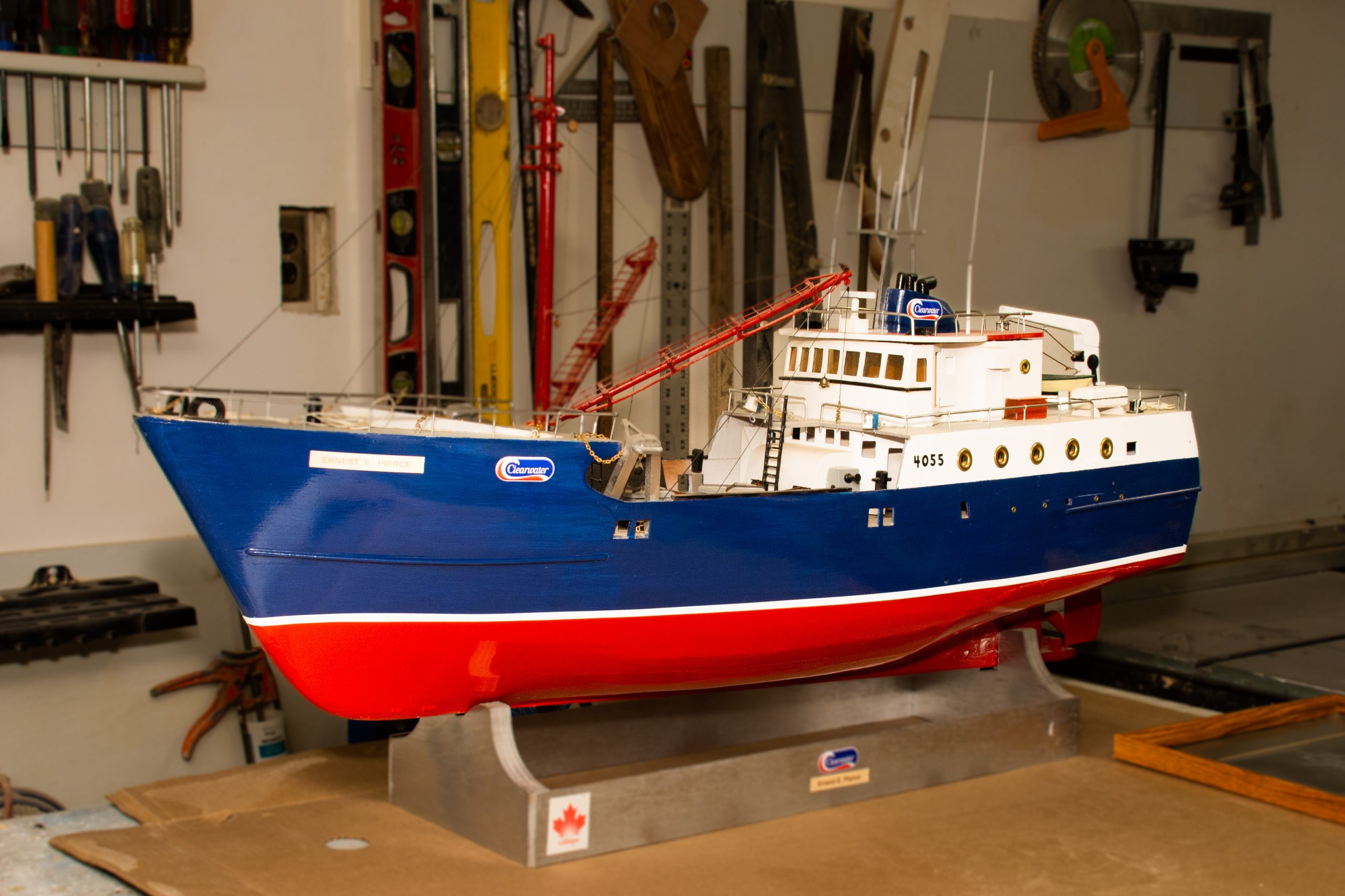
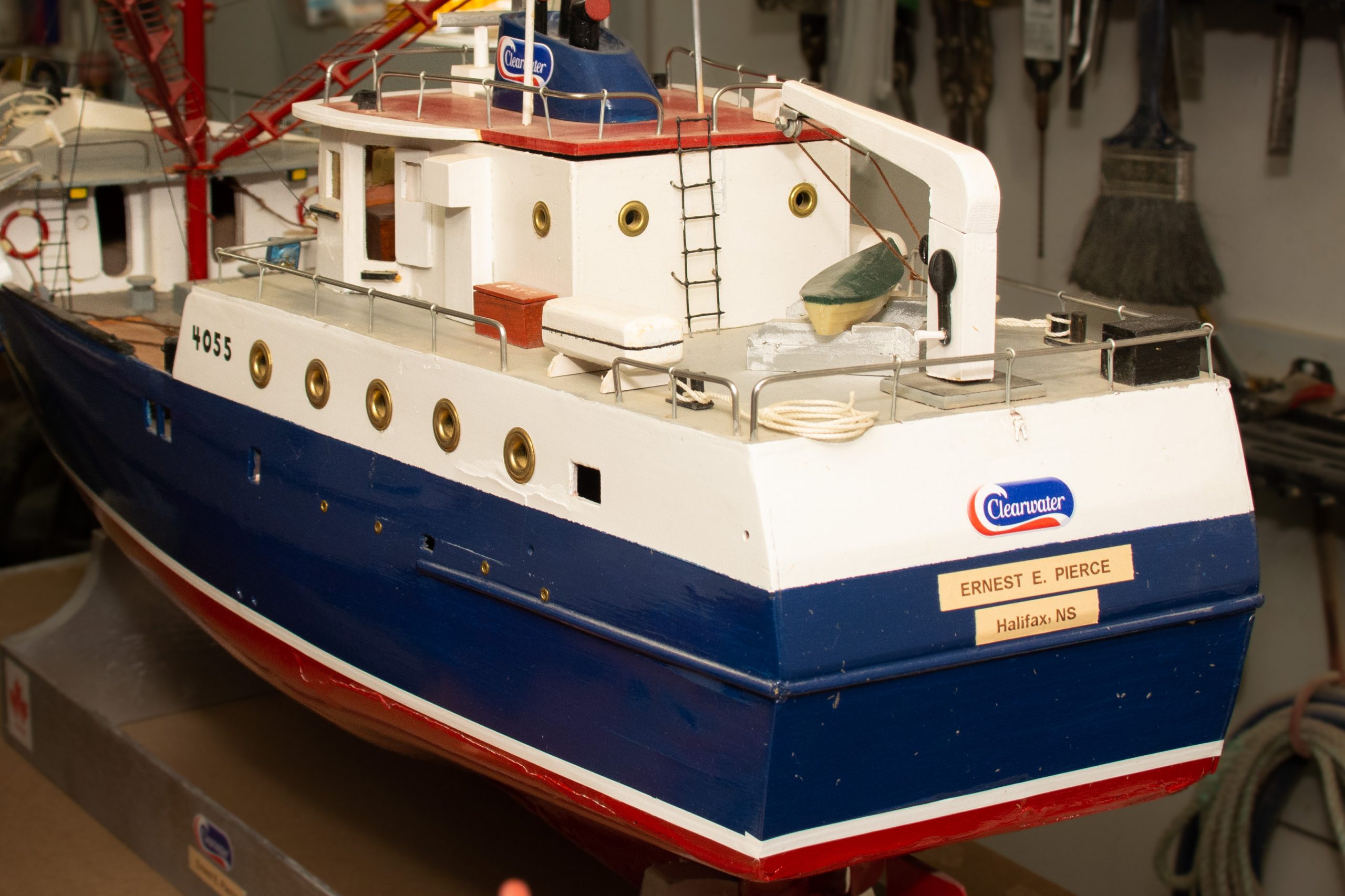
Kevin not only makes boats, he repairs them. And it has to be a pretty damaged boat to be beyond Kevin’s skills. “This one is one that Clearwater is running now. She’s is a scallop dragger. She’s called the Ernest E. Pierce,” he said showing me a wonderfully finished boat with a blue hull and white superstructure and rigged as a side dragger. The model measured about 40” long by 10” wide. The boat it’s modelled on is 127 feet which is about 1:38 scale. He said when he got it from a fellow in New Brunswick, “It was smashed. Maybe half a boat left when I got it. I took it and rebuilt it.”
The actual Ernest E. Pierce was one of a number of old side trawlers Clearwater (a fish processing company) had bought from Newfoundland for not a lot of money and converted to scallop draggers, essentially trading the net for a rake that scrapes the seabed for scallops.
“This one ended up being the Ernest E. Pierce. She fishes out of Lunenberg.”
Kevin worked at the Clearwater plant on the Lobster Plant Road for 25 years. He landed there sometime after the fishery moratorium in the nineties, an event that had a devastating economic impact on the area.
The S.S. Arrow
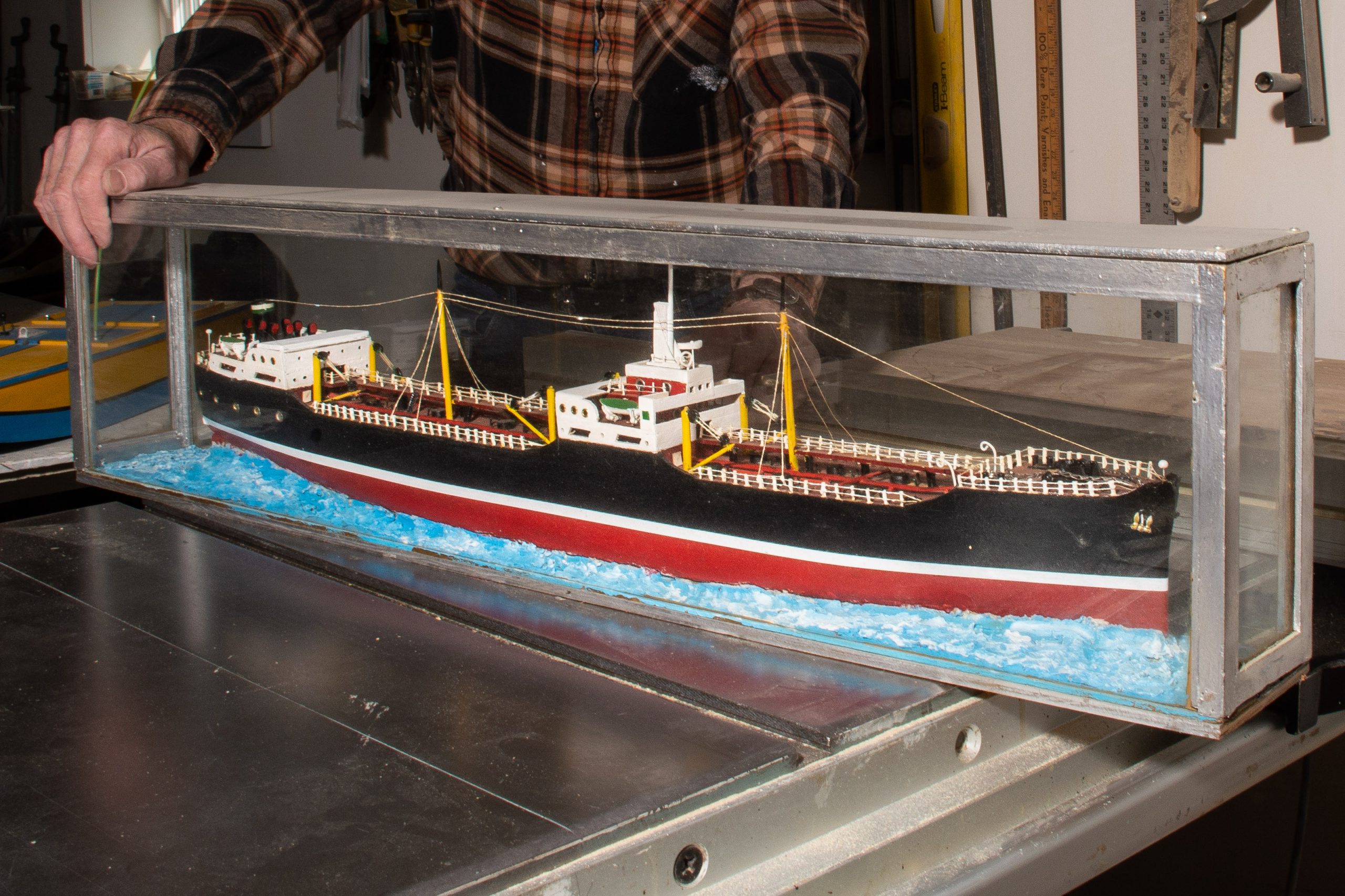
And as if Kevin didn’t have enough boats he’s bought a few to add to his collection of 25 or so. One he truly values is the replica of the infamous oil tanker SS Arrow that wreaked such havoc in the Isle Madame area on February 4, 1970. He said, “Someone had it (the model), didn’t want it. It was all broken, said it could never be fixed and I said give it to me. And I fixed it.”
I had already read about this bit of Isle Madam history, Wikipedia, mostly, but Kevin brought it to life. “This is the one (the Arrow) that’s out by the big island (Jerseyman Island). It’s out here behind the island. It split. Sunk. At low tide you can see the top part of the wheelhouse.
“She broke off at the arse end and swung around this way. They towed the arse end away and this piece went down. She was an awful mess back here in the seventies. I was here. They put off the lobster season and fishing season. There were beaches you couldn’t walk you’d be walking in that much crude oil.”
The Arrow episode really isn’t even over now, 50 some years later. “They’re using it for a diving wreck. They go down and dive all summer long,” he said. There are a lot of stories about the Arrow to be told and that adds to the value of his model. “I won’t part with it,” he said.
The Yet To Be Named
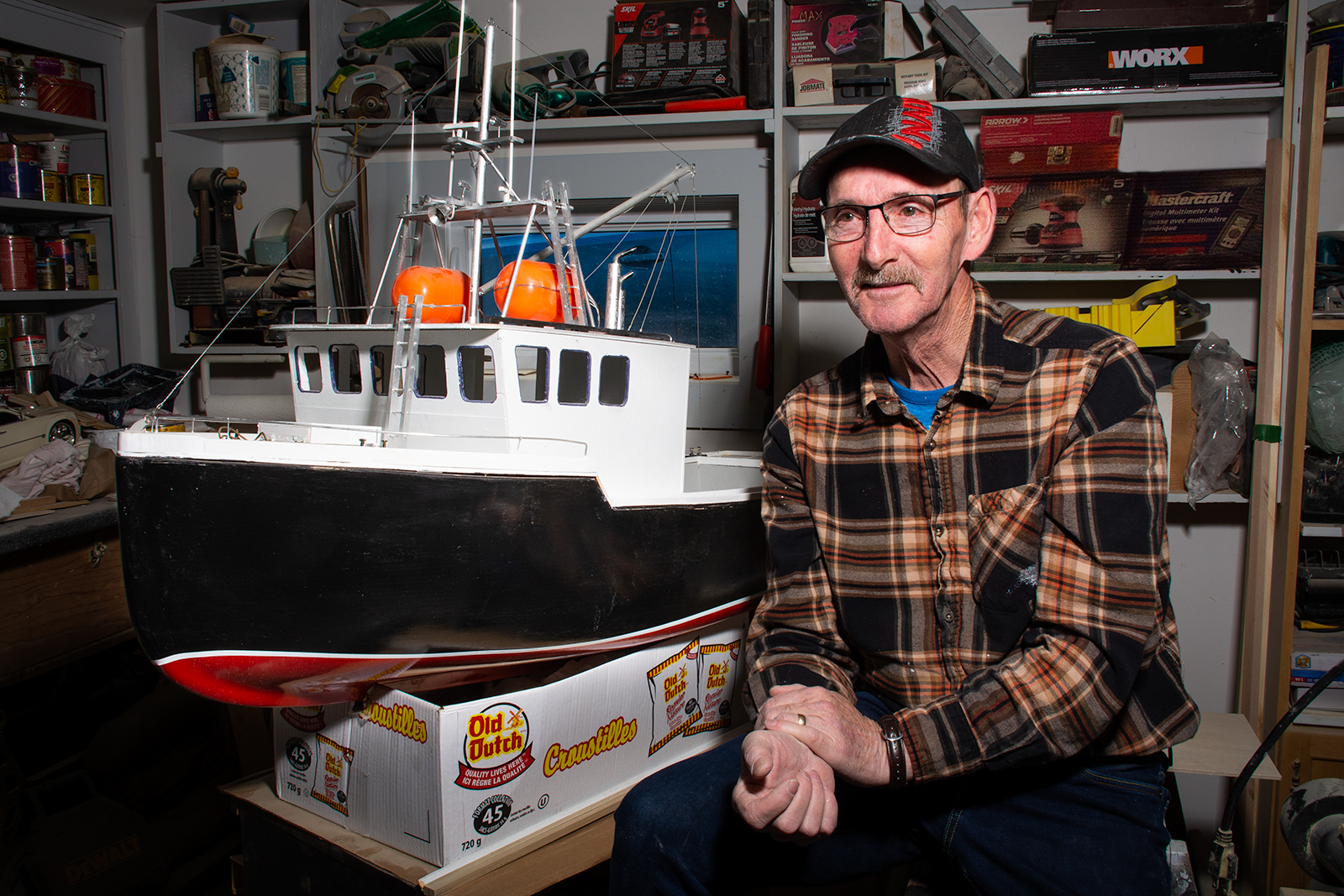
And then there is the one he was making when I met him. “This one’s going to be a lobster boat. A lobster and crab boat. It’s not one in particular. It’s just one I’m making up on my own. There’s a lot of them around here like it.”
He puts a lot of time into these boats. “I usually come down at 5 o’clock in the morning and I go back upstairs at 11 o’clock at night, go to bed for four hours and I’m up again. That’s when I really get into it.” Although he claims it’s a great hobby, most people don’t think of hobbies as taking such a big of chunk out of the day.
His boat building, however, is no assembly line. What he likes is how much variety there is among boats out there and he strives to replicate that individuality in his shop, authenticity being a critical factor. He said, “I build them according to scale. Whatever goes into the boat goes in there.” But that presents a challenge because these boats are not made from kits; they’re made from scratch which requires a large degree of ingenuity, something I should have picked up on by that point in the interview. “If you want to know what some of the parts are made from,” he prodded me, “they’re mostly mostly recyclable stuff.”
“These are your Kinder Surprise from the kids used as life rafts. These are toothpicks. These are just wooden doweling with drinking straws to make the exhaust system. The horns are made from these here golf tees. Little Christmas bells to make a steering light.” And the list goes on. Clearly, this innovation is no obstacle but part of the fun. “It’s mostly trial and error, most of the time. On their part and on my part.”
By “their part” he is talking about full scale boat builders and how much ingenuity goes into rigging them and I realized that model boat building is really just boat building on a different scale. All the boats Kevin makes are actually seaworthy, many have remote control motors. And while everything may be made from wood and jury rigged, repurposed and recycled materials, everything is accurate because he has two of the toughest audiences: fishermen —and there are a lot in this community — and himself. Kevin comes from a family of fishermen and spent 17 years as a fisherman, starting at 16, and lives in an area where commercial fishing and fishing boats are part of the fabric of the community. And while most of his models are showcased in living rooms and “man caves”, sometimes their seaworthiness is tested and so far none have sunk.
Will he sell this as yet unnamed boat? Sure, if someone wants to buy it. But he seemed unconcerned about whether someone would buy it or not. “I am going to sell it. If not, I’m going to donate it.” He’d be happy with either result.
And once that’s done he’ll get to work on another one. He’s been thinking about the Andrea Gail, a fishing boat that sunk in 1991 in what was called The Perfect Storm. So far there has been at least one book and a movie about the unfortunate vessel so that means there’s lots of story for Kevin to dig into. He’s also been thinking about a vessel one of his brothers sailed on, the Bear Cove Point. “She used to land in here. She’s sunk, too.”
The Six Girls
As to the name of that unnamed boat he was working on, when I returned a week or so later to take the cover photos he announced he had a name for the boat. “That one is going to be named the six girls. Granddaughters, daughters, and the wife.”
How is it made? Everything is made from scratch, recycled or repurposed
- The hull of the Six Sisters was made from fibreglass using a mould.
- The hull of this side trawler was made from balsa wood built out from a frame.
- The gallus is a framework attached to the trawl doors that keep the net open. This replica was made from wood painted to look like steel.
- Parts for the pot or trap hauler were made from wooden doweling and pieces from a Leggo set.
- This miniature lobster trap was made from plastic craft sheets.
- Kevin makes these model traditional homemade anchors called picasses or killicks for his grandchildren to sell at the market.
- Most of the pieces were made from wood but the life raft containers were made from Kinder surprise packages, the steering light a Christmas bell, the horns from golf tees and the exhausts from dowel and bendable straws.
- This net drum for trawl nets was made from wood.
- This sail on the back of a lobster boat kept the boat facing up wind while the fishermen hauled in traps. This sail was made from canvas.

Author details
Archie Nadon, writer and photographer, left Ontario in 76 dreaming of living by the sea. In 2021 it finally happened.
